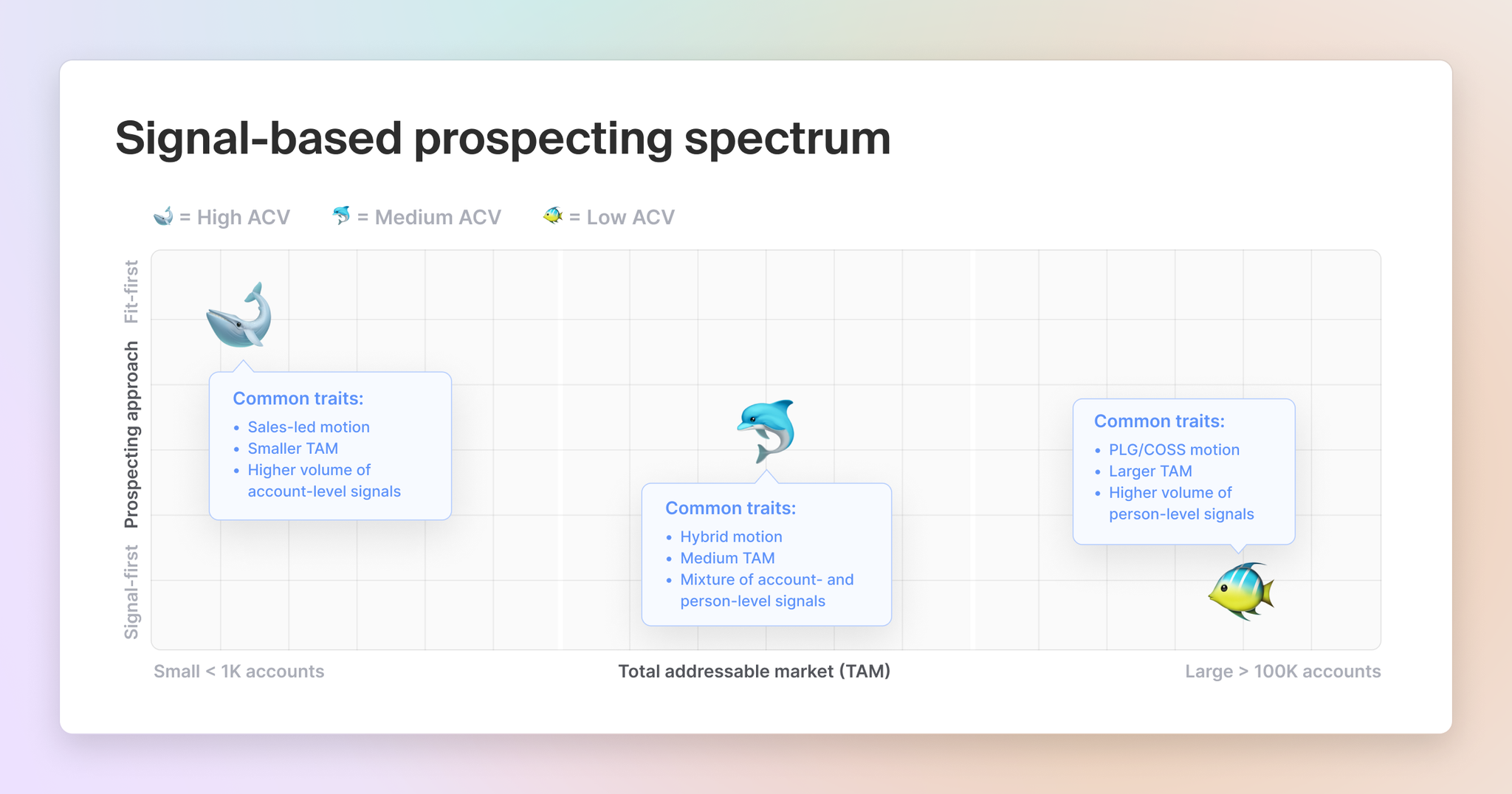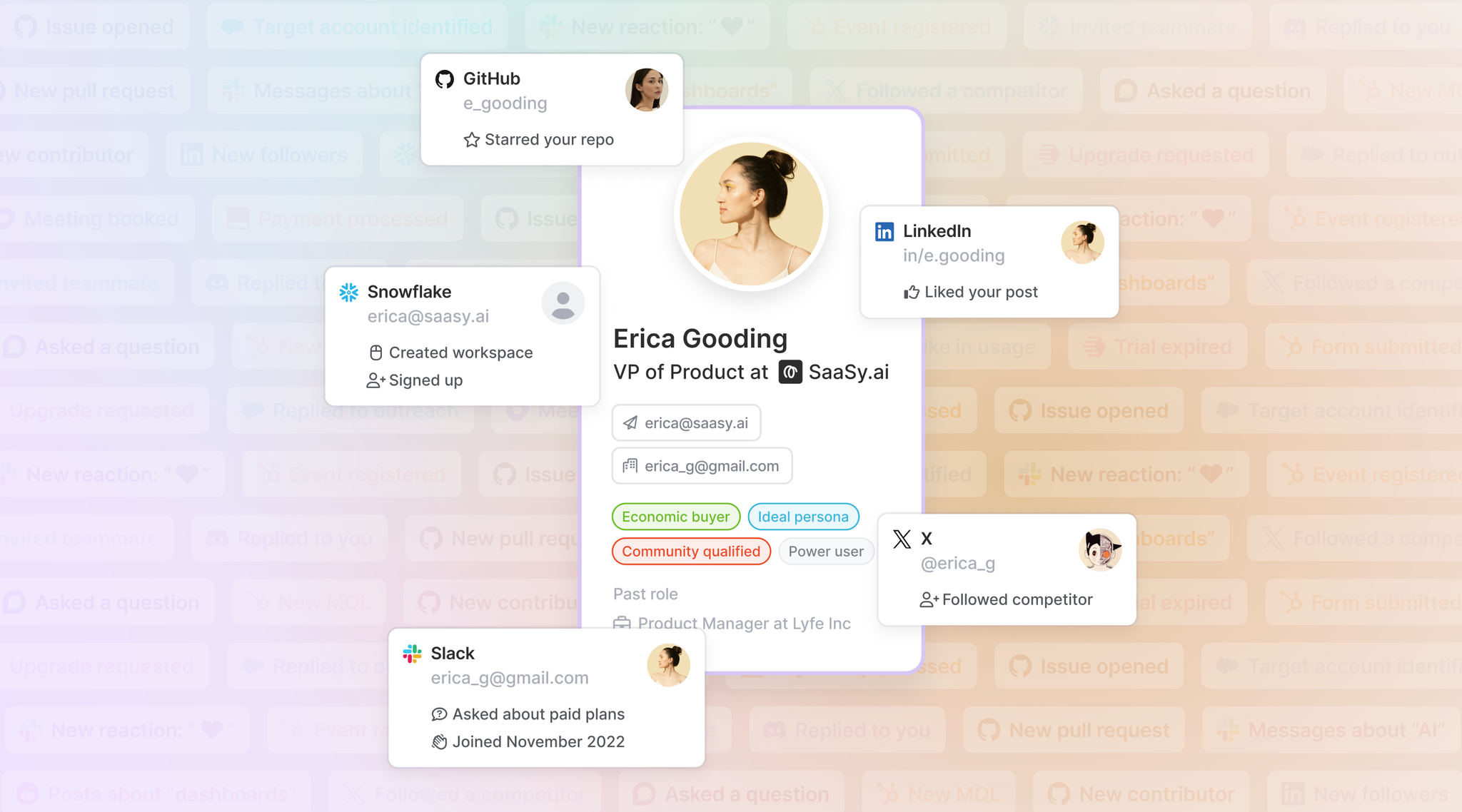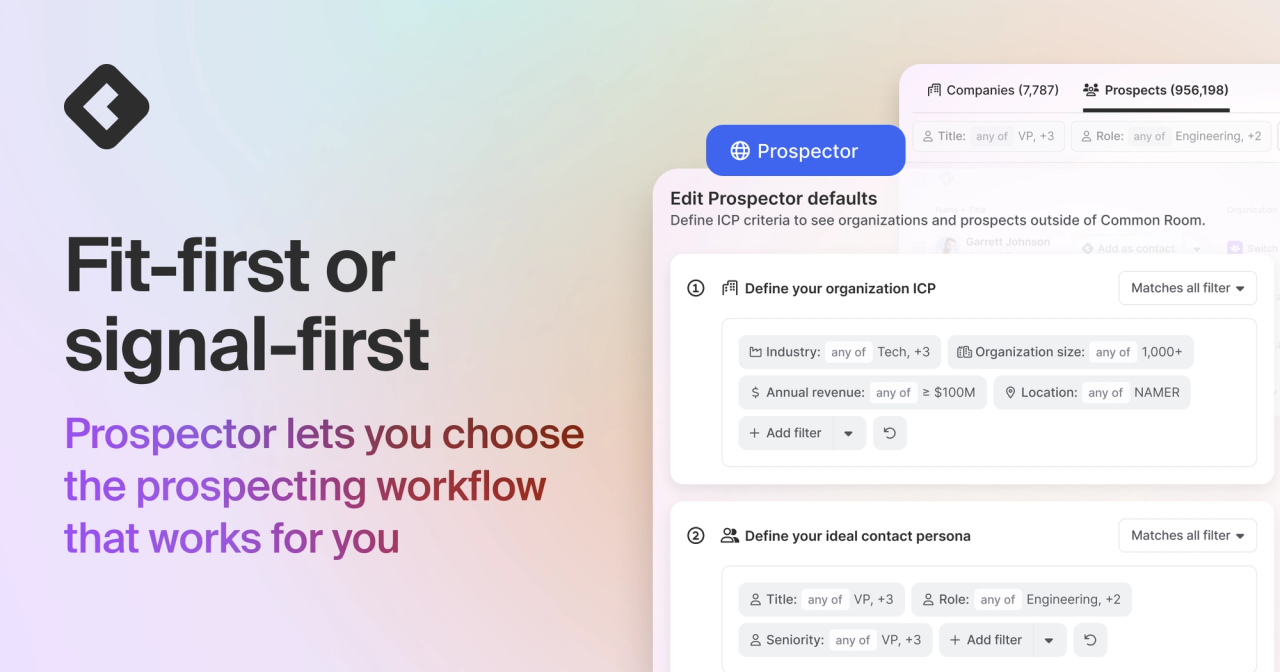- Prospector: Prospect the way that best fits your business using Prospector—now available from the globe icon in the left sidebar of Common Room or a dedicated tab within any Organization profile.
- Fit-first: Define your criteria for ideal customer profile and contact persona, surface companies and prospects from a constantly refreshed database of more than 200M B2B contacts and organizations, and layer on signal data—including job listings, news events, and job changes—to pinpoint the right accounts and buyers.
- Signal-first: Capture account- and person-level buying signals across channels to spotlight in-market buyers, layer signal data over granular fit criteria to prioritize prospects and companies, and uncover the right people to outreach at every org.
- Automated: Automate the prospecting process from end to end, like automatically spotlighting key stakeholders at ICP-match accounts or finding high-fit prospects based on account-level web visits and sending them straight to outbound sequences.
When we look at how Common Room customers approach prospecting, there are two general workflows: fit-first or signal-first.
Some customers target accounts based on ideal customer profile and contact persona, then search for buying signals to prioritize accounts and tailor their messaging.
Other customers surface prospects based on signals that indicate intent, then qualify and prioritize them by drilling down into firmographic and demographic fit criteria.
Both workflows combine buyer actions and attributes. The difference is in the starting point.
It’s not merely a matter of preference. Go-to-market motion, target audience, brand awareness—they all play a crucial role in which workflow makes the most sense.

For example, if you’re a product-led or commercial open-source company with a huge total addressable market and high brand awareness, you’ll naturally generate a lot of first- and second-party signals. Think things like free trial sign-ups, GitHub stars, website visits, and social interactions.
But if you’re a sales-led company with a more limited addressable market and less brand recognition (say a new startup chasing the top telecoms companies in the US), signal-first prospecting might not always be a viable option. At the very least, you’ll need to index more heavily on third-party signals, like job changes, hiring trends, and news events (think priorities identified in public forums, like 10-Ks, earnings calls, and interviews).
It’s not always black and white. Some organizations (like us!) switch up their workflows depending on the type of play they’re running. In fact, different sales teams within the same companies often leverage different tactics. We’ve seen that enterprise sellers are much more likely to drill down into fit first than their teammates in SMB.
Our customers run the gamut, from startups just exiting stealth to long-established enterprises. GTM motion, audience, and awareness all impact the breadth and depth of the signals at their disposal–as well as how they want to put those signals to work.
That’s why we built Prospector to power every prospecting workflow, no matter which flavor makes sense for your organization.
It’s also why we made granular job-change, hiring, and news data—including access to 150 million job listings and 8 million news articles refreshed daily—part of Prospector. We know not every org generates the same volume of signals, but we believe every org should be able to execute a signal-based sales strategy.
Fit-first or signal-first—the choice is up to you. Either way, Prospector is designed to help you find the right buyers and follow up fast, even when you’re away from your keyboard.
Fit-first prospecting
When we launched Prospector earlier this year, we gave Common Room customers access to a proprietary, constantly refreshed database of 200 million-plus B2B contacts.
This allowed users to quickly uncover economic buyers at known accounts, even if those contacts weren’t active in their digital ecosystems or tracked in their CRMs. No tabbing back and forth between enrichment tools necessary.
With the click of a button, new contacts could be added to Common Room and enriched via our identity resolution and waterfall enrichment engine, Person360™. Any buying signals detected over time would automatically be added to a prospect’s (and account’s!) profile.

“Common Room is already our command center for generating and centralizing signals across digital channels. We’re excited to expand even further by pulling in hard-to-see third-party signals like company news and job listings, not to mention the ability to surface new economic buyers who aren't yet engaging with us in target accounts via Prospector.”

Aisha Nins
GTM Program Manager
We expanded the scope of Prospector this summer—now available from the globe icon in the left sidebar of Common Room or a dedicated tab within any Organization profile.
Today you can surface any company that matches your ICP criteria. Whether you’re filtering for industry, size, revenue, location, or some other firmographic detail, Prospector will put the companies you care about right at your fingertips—minus the tedious grunt work.
Better yet, we’ll also reveal the ideal contacts at those accounts based on your criteria for job title, role, seniority level, and even LinkedIn follower count.

But we went one step further. We also built access to third-party signals—including job changes, job listings, and news events—directly into Prospector.
Ideal personas who landed a new gig. Surges in hiring for business-relevant roles. Expansion plans mentioned in 10-K filings or news stories. It’s all available out of the box.
This is a game changer for our customers with limited signals to draw from. Not only can they instantly build lists of high-fit target accounts, they can also see which accounts to prioritize based on activities and events that indicate a prospect or company is in market.
How our customers prospect fit-firstOne of our customers in the cybersecurity sector has a relatively small TAM.
While it’s a fairly well-known brand with a significant amount of owned signal data to pull from, it’s much more concerned with surfacing companies that fit its granular fit criteria (enterprise organizations operating in a highly regulated space, in this case). Using Prospector, it makes sure reps are laser-focused on the right organizations only.
Reps can quickly identify and enrich people at the companies that they want to sell to (part of their playbook is multithreading through multiple departments at the director-level and above) and use both person- and org-level signals to reach out with relevance (new hires and open headcount in particular give reps a reason to get in touch and kick off a conversation).
This allows reps to concentrate on “golden accounts” and craft more compelling messaging even if those accounts aren’t generating a ton of buying signals.
Signal-first prospecting
On the flip side, Prospector also makes signal-first prospecting far easier.
Sometimes our customers only had account-level signals to work with and pinpointing decision-makers was a struggle.
Other times they had a plethora of person-level signals—like free trial sign-ups for their product—but they weren’t coming from the budget holders reps wanted to talk to.
Prospector helps you save time that would otherwise be spent trying to dig up the right buyers by hand. Or, in many cases, begging your one point of contact at a company to put you in touch with their colleagues.
Product usage, website visits, social engagements, open-source activity, community interactions, job changes, job listings, new stories—whatever combination of signals fuel your outbound motion, Common Room serves them up on a silver platter all in one place.

Once you discover a prospect or company sending out buying signals, simply tell Prospector to surface your ideal personas at those accounts.
How our customers prospect signal-firstOne of our customers has a product-led growth motion powered by a generous free trial.
Since its product appeals to multiple personas and is self-serve, it has no shortage of product usage signals to comb through. It uses Common Room’s enrichment to connect Gmail addresses to business accounts. Then it uses calculated fields to spotlight accounts generating a high volume of signal in conjunction with signal-based scoring that evaluates orgs based on a combination of specific behaviors and characteristics.
Once it prioritizes which accounts to go after, it uses Prospector to uncover the economic buyers at those accounts, even if they’re not the ones currently active in the product.
This allows reps to take both a top-down and bottom-up approach to outbound.
Automated prospecting
Whether you prospect fit-first or signal-first, the release of our Prospector workflow feature allows you to do end-to-end prospecting on autopilot.
You can set your parameters in Common Room’s user-friendly workflow builder—including any fit criteria or buying signals that you want to focus on—automatically surface companies and prospects that match your criteria, and add contacts to prioritized burndown lists, Salesforce campaigns, HubSpot workflows, or personalized outbound sequences automatically.
Anonymous visitor checking out the pricing page on your website? You can program Prospector to automatically surface the best prospects at that account, enrich them in Common Room, and send them to a buyer segment. Then automate outreach to everyone on that list via a pre-built email sequence.

Or maybe you’re interested in enterprise orgs in a certain industry and geographic region? You can configure Prospector to surface the right orgs, uncover contacts who recently joined the company, automatically segment them, and have that segment feed into a personalized job-change sequence.
Whether you want last-mile control of full automation, Prospector makes it possible to prospect how you want, when you want.
How our customers automate prospectingOne of our customers has a very popular open-source project that generates leads for its paid offering.
It created a series of workflows in Common Room that handle lead gen without any human intervention. First it automatically prospects into ICP-match accounts that star its repository in GitHub to find economic buyers and add them to a segment. These contacts are then pushed to personalized nurture campaigns in the company’s email automation platform.
After either signing up for a demo or receiving a set number of emails, prospects are handed off to sales to book a meeting.
This allows marketing and sales to go after high-intent, high-fit accounts automatically and at scale.
You’ve probably noticed that we’re big fans of choice here at Common Room.
Choice in buying signals. Choice in AI. Choice in tooling.
That’s why we give every customer choice in how to build quality pipeline faster based on their unique business needs.
Fit-first or signal-first—we built Prospector for you.
Prospect how you want with Common Room
Get started for free or get in touch to see how Common Room can help you surface high-fit, high-intent prospects and companies quickly and scalably.

